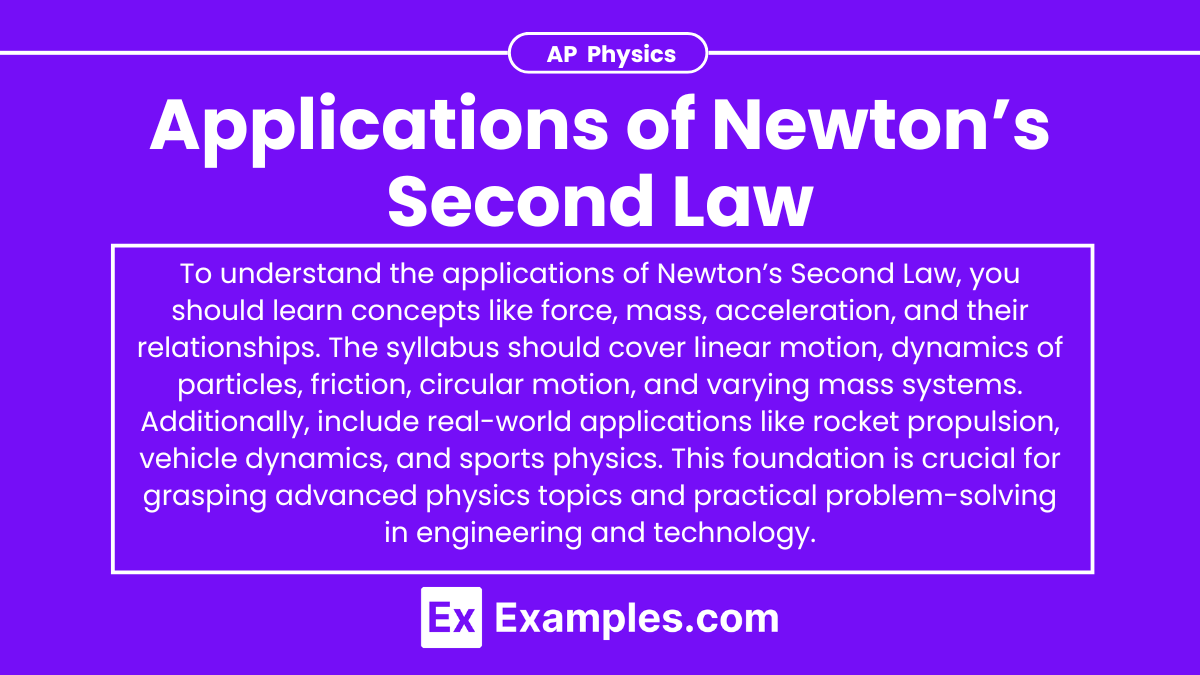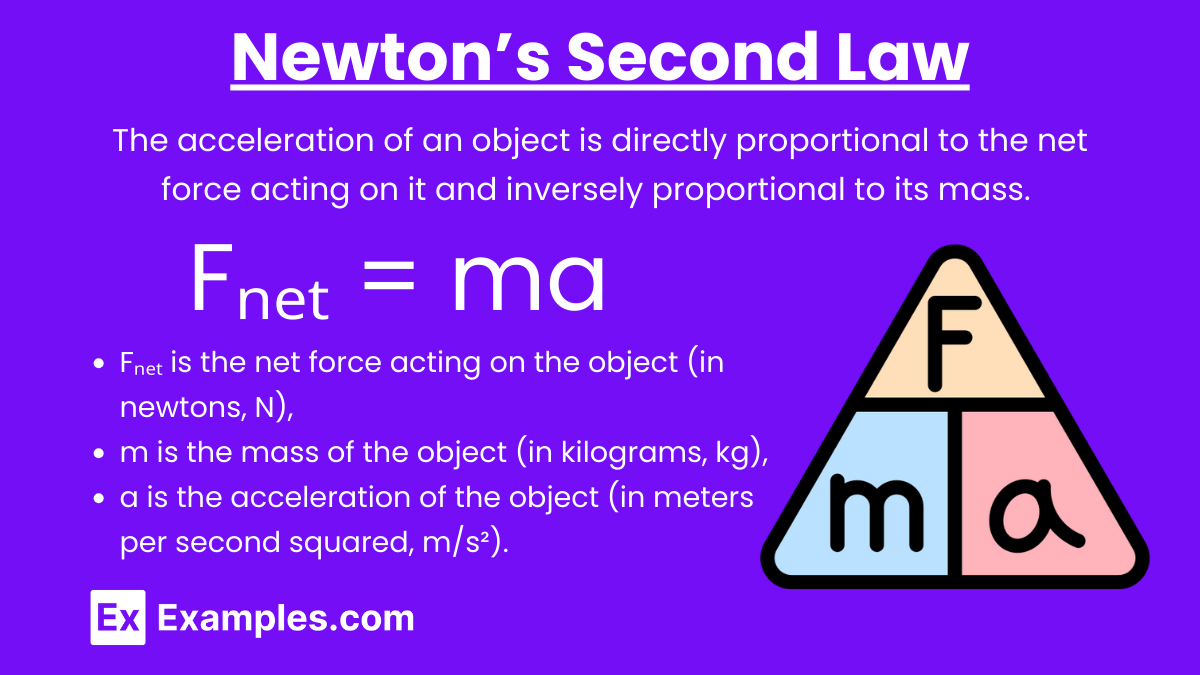Newton's Second Law of Motion is fundamental in understanding the dynamics of objects. This law relates the net force acting on an object to its mass and acceleration. Below are detailed notes on various applications of Newton’s Second Law to help you achieve a high score on your AP Physics exam.
Free AP Physics 1: Algebra-Based Practice Test
Learning Objectives
You will learn how to apply Newton's Second Law to solve problems involving various forces, including friction, tension, normal force, and gravity. You will understand how to calculate net force, mass, and acceleration in different scenarios. You will explore the applications of this law in real-world contexts, such as inclined planes, pulleys, and circular motion. Additionally, you will develop problem-solving skills and critical thinking necessary for the AP Physics exam.
Definition of Newton’s Second Law
Newton’s Second Law of Motion: The acceleration of an object is directly proportional to the net force acting on it and inversely proportional to its mass. Mathematically, it is expressed as:
Fₙₑₜ = ma
where:
Fₙₑₜ is the net force acting on the object (in newtons, N),
m is the mass of the object (in kilograms, kg),
a is the acceleration of the object (in meters per second squared, m/s²).
Applications of Newton’s Second Law
1. Automotive Design and Safety
Newton's Second Law is crucial in designing vehicles and safety features:
Braking Systems: Engineers design brakes to apply a force that decelerates a car at a safe rate.
Crash Testing: Safety features like airbags and crumple zones are tested to see how they decelerate passengers, minimizing injury.
2. Sports and Athletics
Athletes and coaches use Newton's Second Law to improve performance:
Training: Understanding how to apply force effectively helps athletes accelerate quickly and move efficiently.
Equipment Design: Sports equipment, like bats and rackets, is designed to maximize the force applied to the ball, optimizing performance.
3. Space Exploration
Newton's Second Law is essential for planning and executing space missions:
Rocket Launches: Calculating the force needed to overcome Earth's gravity and propel spacecraft into orbit.
Orbital Maneuvers: Determining the thrust required to change the velocity and trajectory of spacecraft.
4. Engineering and Construction
Engineers apply Newton's Second Law in various construction and mechanical processes:
Structural Analysis: Ensuring buildings and bridges can withstand forces like wind and earthquakes.
Machinery: Designing machines that apply forces to perform tasks efficiently and safely.
5. Everyday Activities
Newton's Second Law explains common experiences and actions:
Pushing Objects: When you push a heavy object, the amount of force you apply determines its acceleration.
Driving: The acceleration of a car depends on how much force the engine produces relative to the car's mass.
6. Aerospace Engineering
Newton's Second Law plays a critical role in the design and operation of aircraft and spacecraft:
Thrust Calculation: Engineers determine the necessary engine thrust to achieve desired accelerations during takeoff, flight, and landing.
Stability and Control: Analyzing forces acting on an aircraft to maintain stable and controlled flight.
7. Robotics
Robotics engineers use Newton's Second Law to design and control robots:
Movement and Manipulation: Calculating the forces required for robotic arms to lift and move objects.
Autonomous Navigation: Determining the forces needed to accelerate and decelerate robots, ensuring smooth and efficient movement.
8. Biomechanics
Newton's Second Law is essential in studying human and animal motion:
Gait Analysis: Evaluating the forces exerted by muscles to produce walking or running movements.
Prosthetics Design: Designing artificial limbs that replicate natural motion by applying appropriate forces.
9. Manufacturing
Manufacturing processes often rely on Newton's Second Law:
Machining: Calculating the forces needed for cutting, drilling, and shaping materials.
Assembly Lines: Designing machines that apply the correct forces to assemble products efficiently.
10. Renewable Energy
Newton's Second Law aids in the development of renewable energy technologies:
Wind Turbines: Analyzing the forces exerted by wind on turbine blades to optimize energy capture.
Hydroelectric Power: Understanding the forces of flowing water on turbines to maximize power generation.
Examples
Pushing a Cart:
If you push a 10 kg cart with a force of 20 N, the acceleration is: a = \frac{F_{\text{net}}}{m} = \frac{20 \, \text{N}}{10 \, \text{kg}} = 2 \, \text{m/s}^2Falling Object:
A 5 kg object in free fall experiences a gravitational force of Fg=mg. Fg = 5kg×9.8m/s² = 49N
Example 1: Sliding Box with Friction
Scenario: A 15 kg box is sliding on a horizontal surface with a kinetic friction coefficient of 0.3. If a horizontal force of 50 N is applied, determine the box's acceleration.
Calculations:
Normal force: F_N = mg = 15 \, \text{kg} \times 9.8 \, \text{m/s}^2 = 147 \, \text{N}
Frictional force: f_k = \mu_k F_N = 0.3 \times 147 \, \text{N} = 44.1 \, \text{N}
Net force: Fₙₑₜ = 50N−44.1N = 5.9N
Acceleration: a = \frac{F_{\text{net}}}{m} = \frac{5.9 \, \text{N}}{15 \, \text{kg}} \approx 0.39 \, \text{m/s}^2
Example 2: Tug of War
Scenario: Two teams are playing tug of war, with team A pulling with a force of 500 N and team B pulling with a force of 450 N. The rope has a mass of 5 kg. Determine the acceleration of the rope.
Calculations:
Net force: Fₙₑₜ = 500N−450N = 50N
Acceleration: a = \frac{F_{\text{net}}}{m} = \frac{50 \, \text{N}}{5 \, \text{kg}} = 10 \, \text{m/s}^2
Example 3: Car on an Incline
Scenario: A car of mass 1000 kg is accelerating up a hill inclined at 30° with an applied force of 4000 N. The frictional force opposing the motion is 500 N. Determine the car's acceleration.
Calculations:
Gravitational force component parallel to the incline: F_{g\parallel} = mg \sin \theta = 1000 \, \text{kg} \times 9.8 \, \text{m/s}^2 \times \sin 30^\circ = 4900 \, \text{N}
Net force: Fₙₑₜ = 4000N−500N−4900N=−1400N
Acceleration: a = \frac{F_{\text{net}}}{m} = \frac{-1400 \, \text{N}}{1000 \, \text{kg}} = -1.4 \, \text{m/s}^2
(The negative sign indicates acceleration down the incline)




